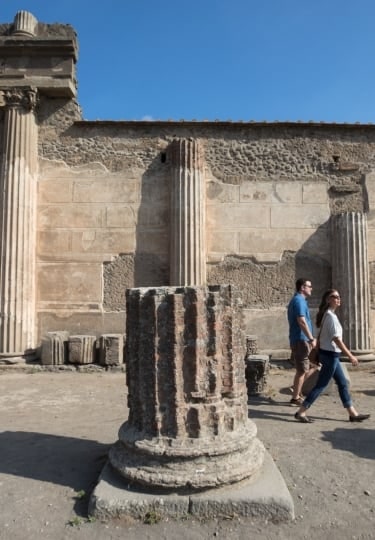A Pompeii day trip is an epic journey into the past. Wandering the resurrected lanes of this once-prosperous coastal town can be a distinctly profound experience.
Buried in 79 AD beneath the debris and lava released when Mount Vesuvius erupted, Pompeii is a frozen moment of life in classical Rome. And it’s a moment still being unearthed, as you’ll see on your trip, with roped-off areas of the park where archaeologists are carefully chiseling, brushing, and unearthing new, remarkable finds.
Located about 30 minutes’ drive from the vibrant city of Naples, a day trip to Pompeii can make for a cultural highlight on a longer vacation in one of Italy’s most seductive southern regions.
The Best Time to Visit Pompeii
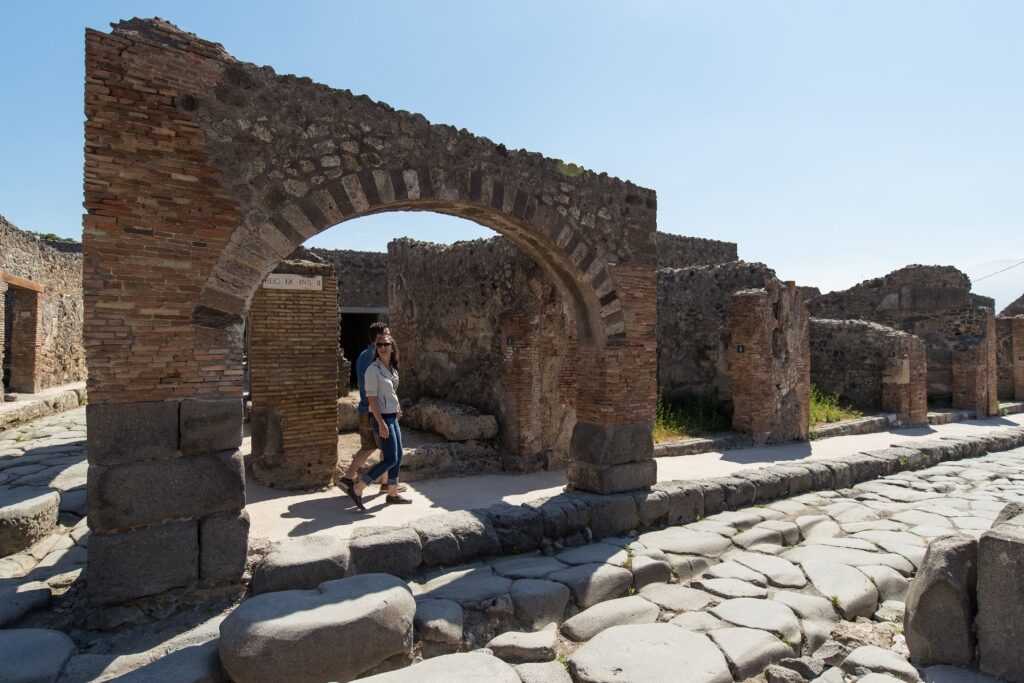
Pompeii
Pompeii in Southern Italy is a fabulous day trip any time of the year. Of course, given that it’s one of the most visited archaeological parks in the world, the summer months can see its recovered villas and bathing houses crowded with the curious.
The best time to visit Pompeii is during the shoulder seasons. May and September are particularly wonderful months in which to visit. The weather is warm, but nowhere near the blistering heat of August, and the high-season crush is absent.
This is one of the best attractions in Europe, so if you can visit during a weekday, then your chances of having the ruins more to yourself are greatly heightened. Trying to visit in the early morning or late afternoon will increase those chances further, as well as help you avoid the powerful midday sun. The park is only closed on three days of the year: December 25, January 1, and May 1.
What to Pack for a Pompeii Day Trip
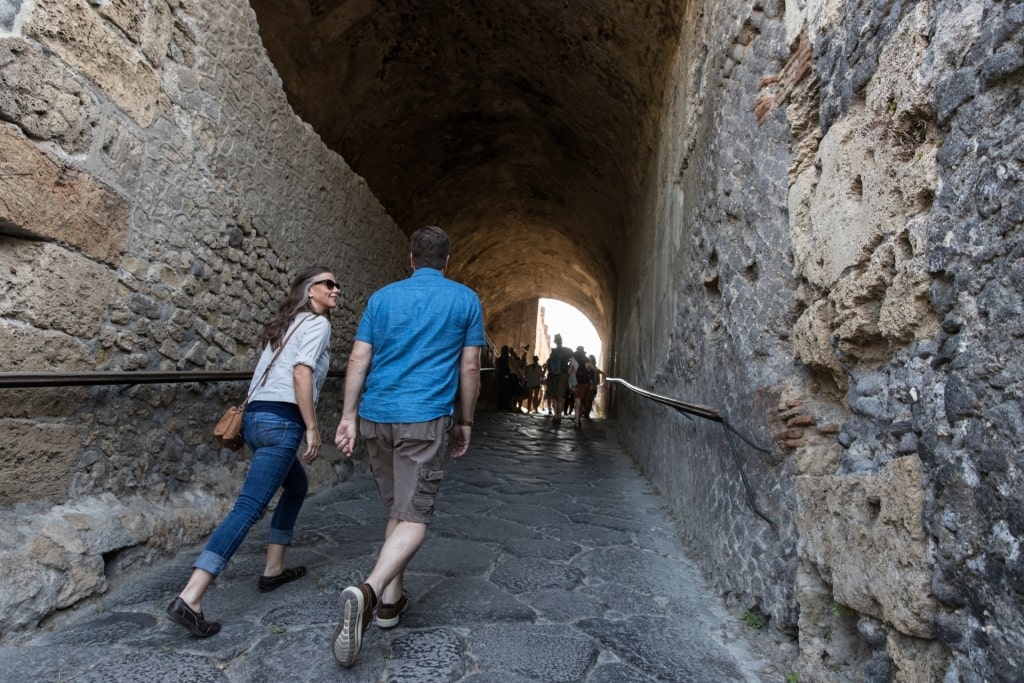
Pompeii
Pompeii is a vast open-air museum broken up into nine must-see regions. It’s situated in one of the Mediterranean’s sunniest spots, so it helps to be well-prepared for your Pompeii day trip.
Ensuring that you’re comfortably dressed, well hydrated, and suitably protected from the sun are the key takeaways of this Italian packing list.
Packing List
- Comfortable sneakers or breathable hiking shoes
- Clothing made from light, breathable fabrics
- Sun protection: Hat or parasol, sunglasses, sunscreen. There is barely any shade at Pompeii.
- Refillable water bottles for the site’s many fountains
- Snacks
- Packed lunch – although well-priced cafés and restaurants are available
- Camera or smartphone
- Portable charger for your smartphone – you will take a lot of photos
- Lightweight backpack
- Lightweight raincoat if you are traveling outside the summer season
Arriving at Pompeii
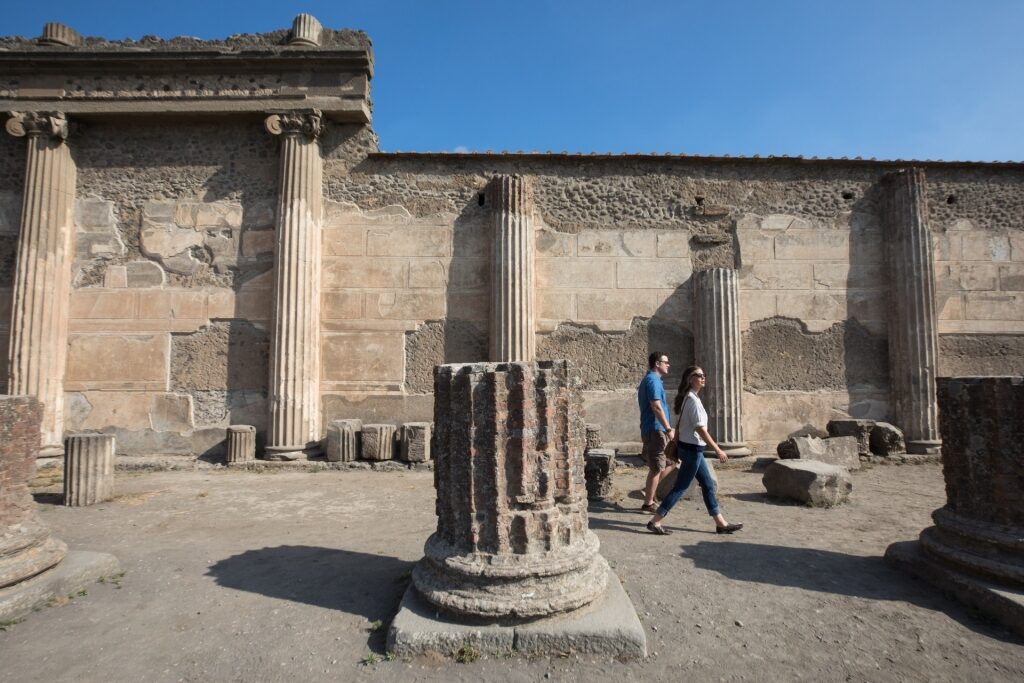
Pompeii
It’s simple to travel to Pompeii, located only half an hour’s drive east of Naples. There is plenty of parking available only a short walk from the Porta Marina entrance. You can make reservations online in advance to ease your parking experience. Otherwise, cash or card is accepted upon arrival.
While there are buses from Naples as well as a Trenitalia train from Napoli Centrale, the best public transport option is the local Circumvesuviana Train.
This useful route, starting in Naples and ending in Sorrento, stops at Pompei Scavi – Villa dei Misteri in between. The journey takes about the same time as a car ride. When you disembark you’ll find yourself at the park’s main entrance.
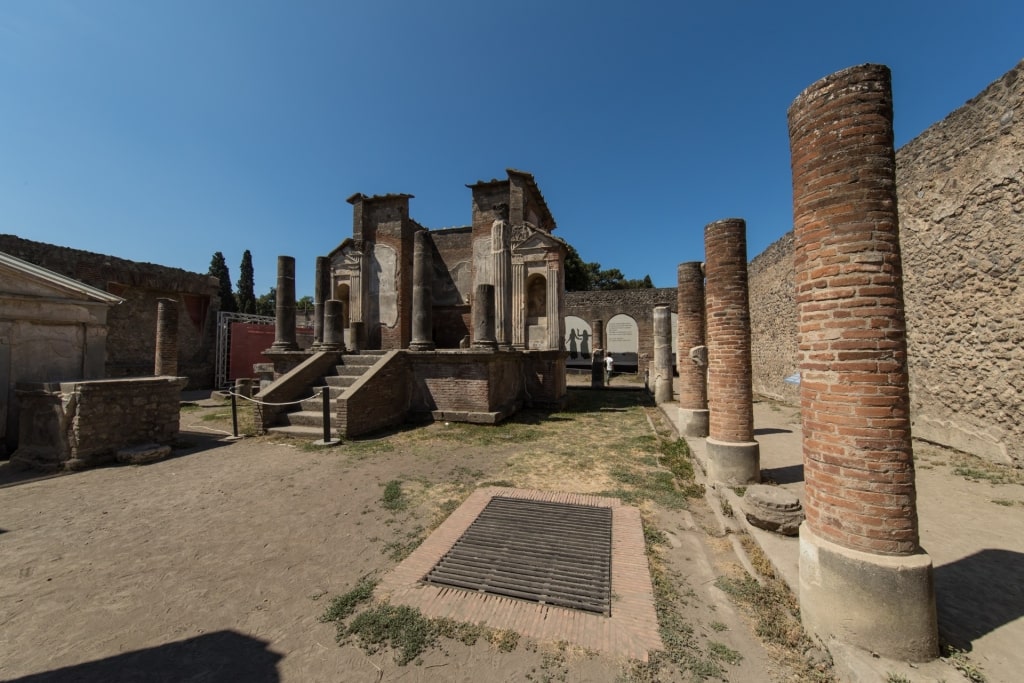
Temple of Isis
Be sure to check ahead if you have some idea of which sites you’re particularly interested in seeing. While the main attractions are usually open, there’s a constant program of restoration and preservation that can see many areas of Pompeii roped off and closed to visitors. Check the website or call ahead to confirm that what you want to see is open when you’re going.
A Brief History of Pompeii
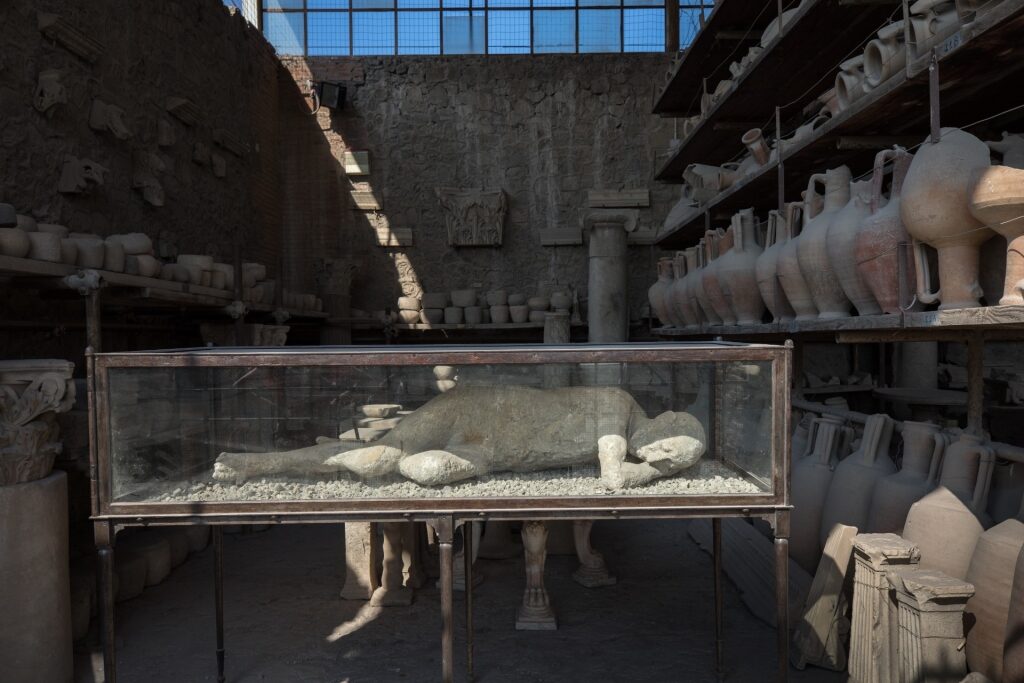
Pompeii
In 79 AD, Mount Vesuvius erupted, throwing an avalanche of pumice, rock, and ash onto the wealthy city of Pompeii, only 10 miles away. Around 2,000 inhabitants were killed instantly in the disaster, their bodies concealed beneath the rubble.
Pompeii would remain hidden beneath the ground until 1599. While excavating a canal route, the Italian architect Domenico Fontana happened upon a part of the city.
However, it wasn’t until around 150 years later that this lost city was the beneficiary of some dedicated excavation. Led by a Spanish military engineer, de Alcubierre, the motivation behind the effort was to unearth priceless Roman treasures.
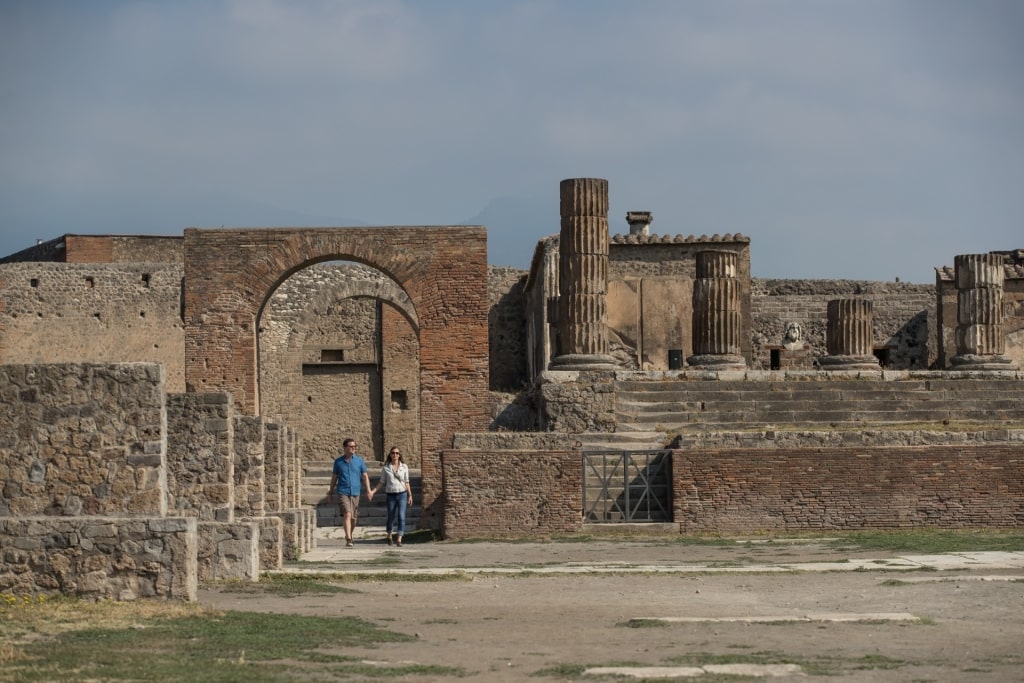
Temple of Jupiter
In 1763, thanks to the discovery of some inscriptions, the site was identified as Pompeii. With its singular importance established, the excavations became progressively more scientific.
The 19th-century archaeologist Giuseppe Fiorelli pioneered the use of plaster, injected into the spaces beneath the rubble, to produce casts of the Pompeiians in their final moments. Today, Pompeii stands as one of the world’s greatest windows into antiquity and one of the best historical places to visit.
Beginning Your Journey
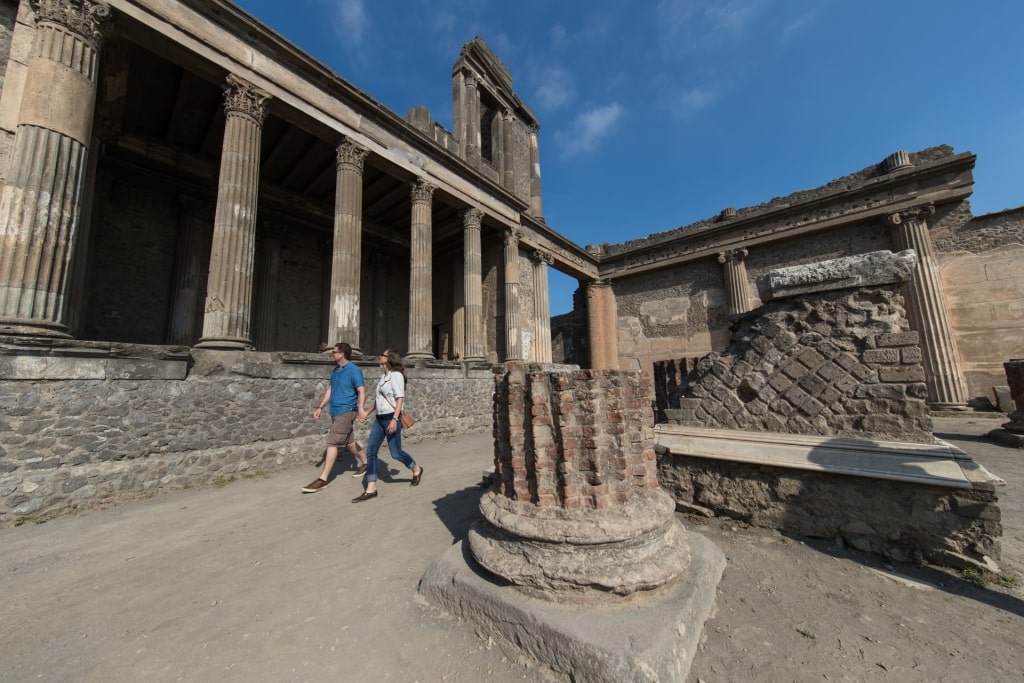
Basilica
The main entrance to the site is Porta Marina, close to where the Circumvesuviana Train drops its passengers. Both this entrance and the Piazza Anfiteatro entrance, located near modern Pompeii, are well equipped with information stops, food shops, and places where you can pick up an audio guide.
Lines quickly form at the ticket office, so the earlier you arrive the better. You can book online in advance, and doing so will help speed up your entry into the park.
At the ticket office, you can also pick up a paper map of Pompeii. If you leave this on an ancient wall somewhere, there’s also a digital map available for download on Pompeii’s official site. To find it, go to the page entitled “Map and Guide to the Excavations”.
Organizing a Guided Tour
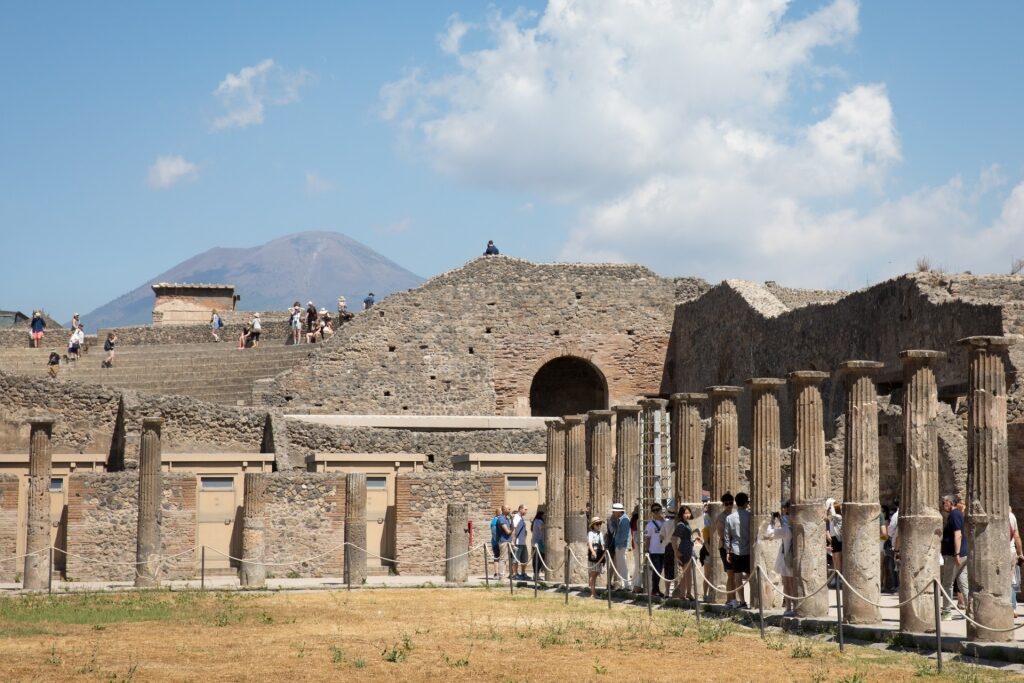
Pompeii
If you would like to take a guided tour and have not joined an organized excursion, find your way to the information desks at Piazza Esedra or the Piazza Anfiteatro entrance. The guides are all professionals, screened by the park, with a deep knowledge of Pompeii and its history.
With your guide, you can work out the route and length of tour that you’d like to engage them for. This, along with group size, will dictate the price. Standardized prices are displayed on the ticket office or their websites.
It’s hard to argue with the value that you’ll receive from a skilled guide bringing the skeletal ruins of Pompeii to life as you walk the streets. The guides can usually share unseen details, such as information about ongoing excavations and new finds.
Where to Eat in Pompeii

Pizza
Snacks alone will not sustain a day trip to Pompeii. The good news is that several restaurants and kiosks are found inside—or very close to—the archaeological park.
Inside the park, close to the Temple of Jupiter, you’ll be able to pick up panini, pizza, and salads at the Chora café.
The Hortus Porta Marina restaurant is found at Porta Marina and offers good value meals. It also has plenty of seating available inside. Just outside the park near the Piazza Anfiteatro entrance in modern Pompeii, you’ll find Cenere—a restaurant offering excellent traditional Italian dishes. Close by, Puro and Bistrot Fratelli Cannavacciuolo are also good options.
Must-See Sites in Pompeii
While all of the archaeological park is a “must-see”, these are the sites that one must not miss on a day trip to Pompeii. You’ll find useful write-ups of these main sights on your map picked up from the ticket office.
The Forum
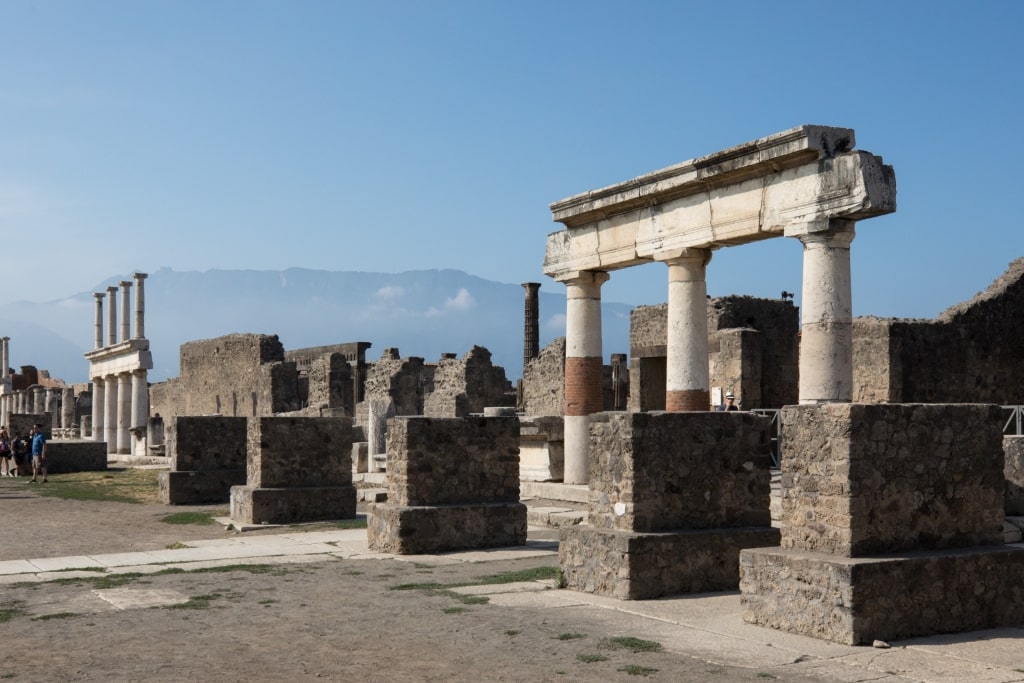
The Forum
The center of Pompeii, this ancient piazza was a hub for politics and commerce. The temples that line the forum also indicate how central religion was for the people of Pompeii.
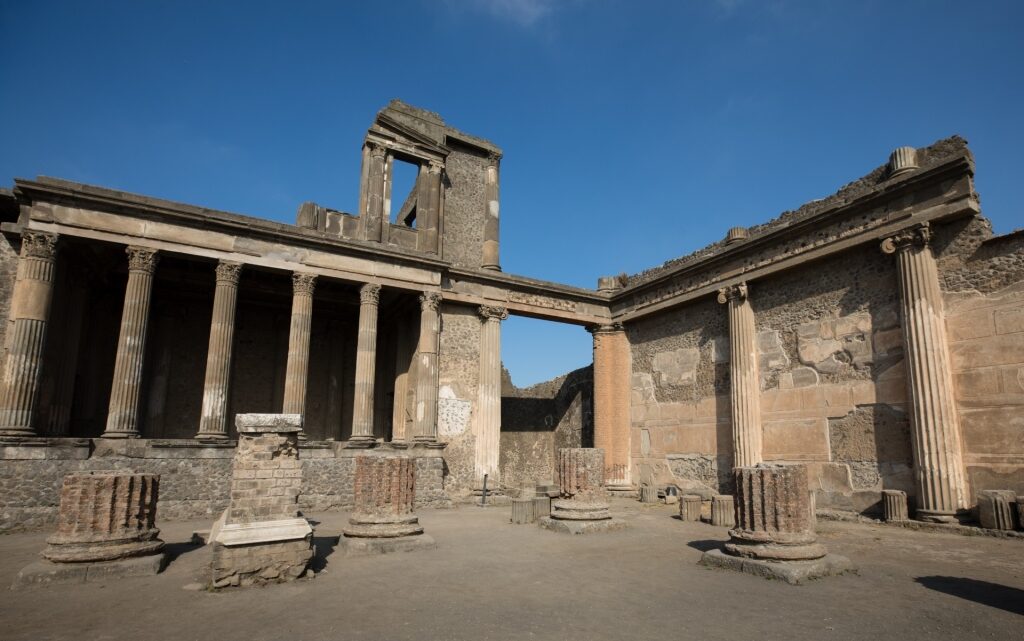
Basilica
Other notable structures found here include the Basilica, the Macellum, as well as various other civic buildings. From the piazza, the view of Vesuvius reaching into the blue sky is striking.
Read: Best Places to Visit in Italy for the First Time
Porta Marina
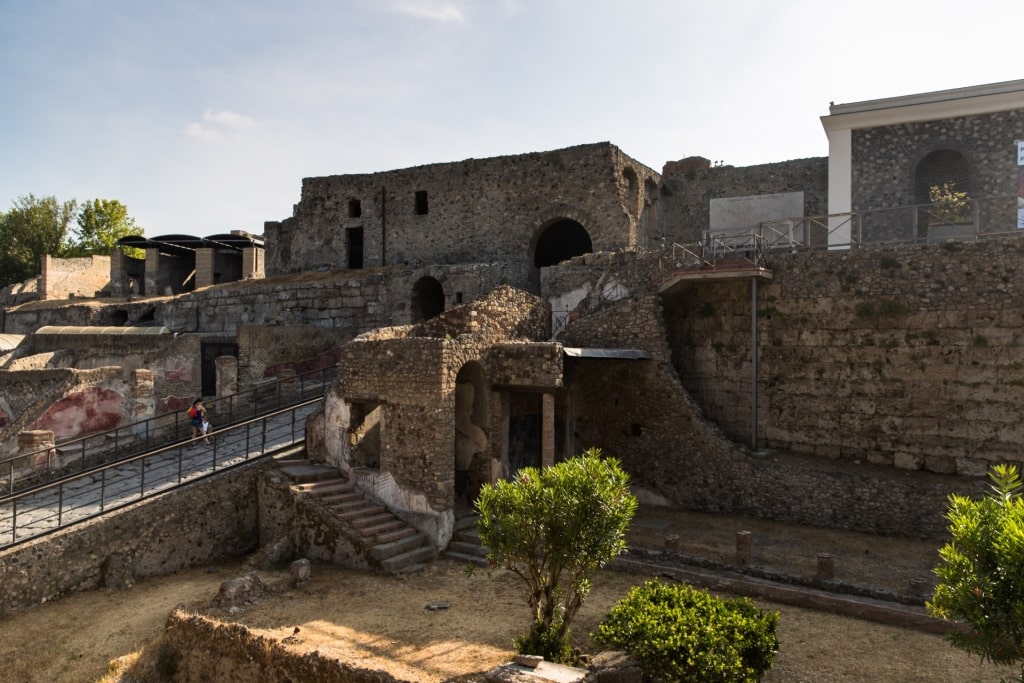
Porta Marina
As the name suggests, this was the gate through which Pompeii was connected with its nearby harbor. It remains one of the main visitor entrances to the park and you’ll find souvenir shops and info desks here.
A key structure in the city’s outer walls, the Porta Marina is built from concrete that dates back to around 80 BC.
House of the Faun
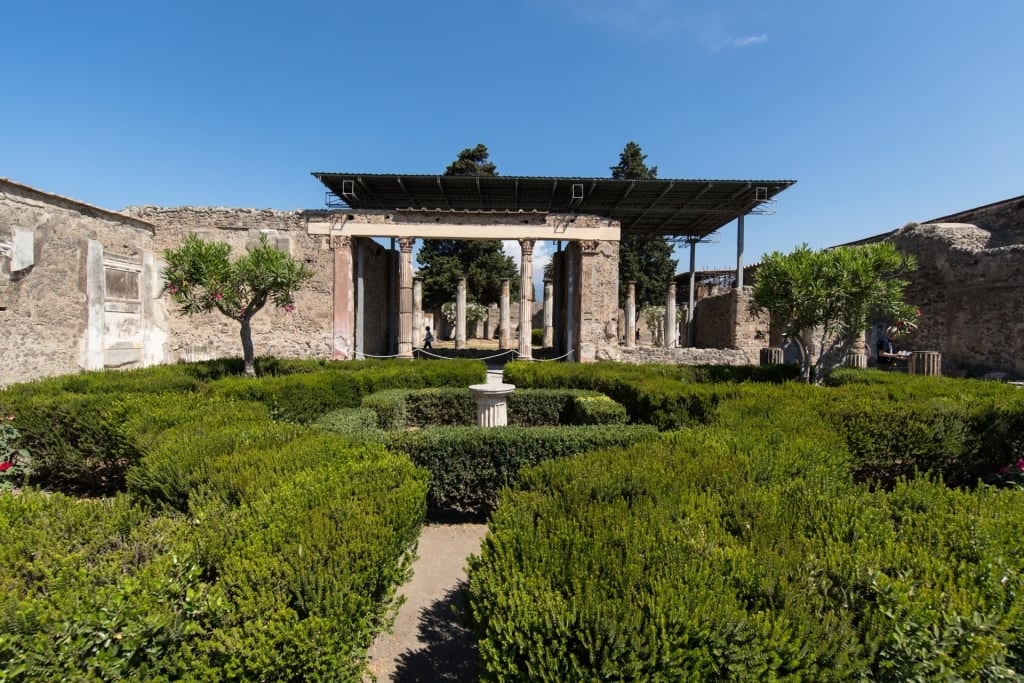
House of the Faun
A huge, 32,000-square-foot luxury villa, the House of the Faun was the residence of one of Pompeii’s richest citizens. With no fewer than two atriums and elaborate mosaics, this sprawling residence is a fascinating glimpse into the lavish lifestyle of the Pompeiian upper class,
The faun statue for which the building is named is now housed in the National Archaeological Museum of Naples.
The Garden of the Fugitives
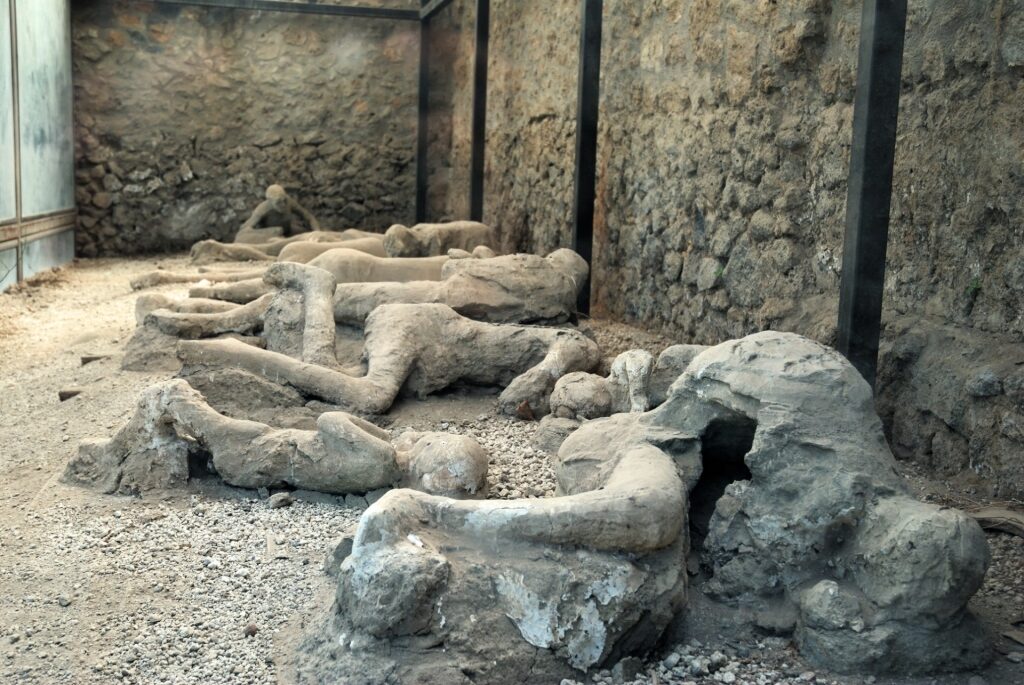
The Garden of the Fugitives
The location of a group of 13 individuals who were trying to escape, the Garden of the Fugitives is one of the most affecting corners of the park. It was formerly a vineyard and you can see the plaster casts of the desperate victims displayed in a glass case.
The Amphitheater
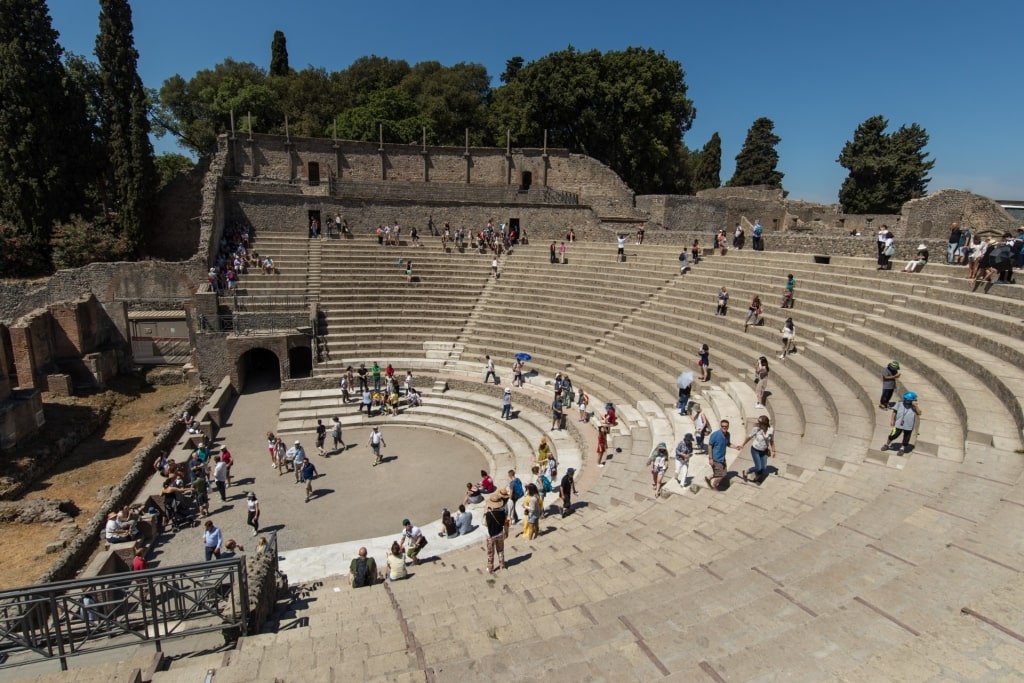
The Amphitheater
Built in 70 BC, this well-preserved amphitheater is one of the oldest examples of its kind. Once capable of seating around 20,000 toga-clad bloodsports fans, the amphitheater was used for a variety of events besides the ever-popular gladiatorial games.
Via dell’Abbondanza
Pompeii’s high street begins at the Sarno Gate and unrolls nearly 3,000 feet to the Forum. When it’s quiet, you can feel the ghosts haunting a street that was once full of houses, cafes, and artisan workshops.
The Stabian Baths
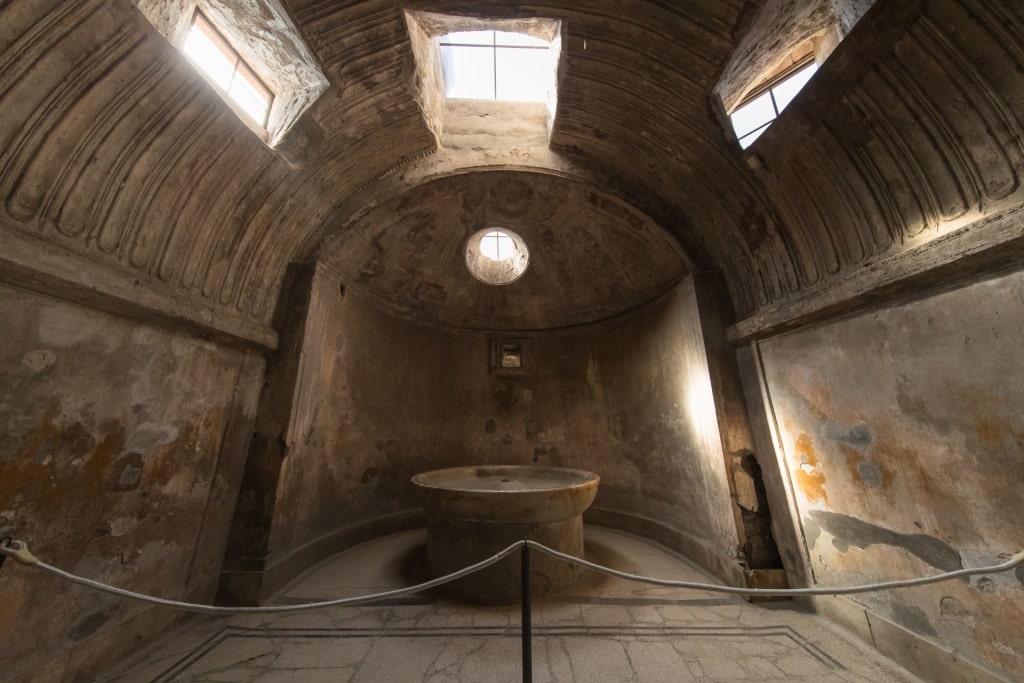
The Stabian Baths
Found on the Via dell’Abbondanza, the Stabian Baths are the largest of a trio of bathing complexes found in Pompeii. While the Stabian Baths are the most elaborate, many visitors tend to remember the Suburban Baths more strongly. Near the Marina Gate, the Suburban Baths are famous for the erotic frescoes in the apodyterium.
Insula dei Casti Amanti
Only open to the public since May 2024, the Insula dei Casti Amanti has long been a tantalizing, out-of-reach treasure. A cluster of homes that includes a bakery, the Insula dei Casti Amanti is named for a painting depicting a pair of lovers on the walls of one of the homes.
What makes the Insula dei Casti Amanti such a good stop on your Pompeii day trip is its elevated pathway. Beneath it are the archaeologists and restorers at work, and watching them from above offers a wonderful insight into the painstaking process of the excavation.
Also to look out for in the Insula dei Casti Amanti are charcoal drawings on the wall of a courtyard, believed to have been made by children, that appear to depict gladiators and a boar hunt. A more grisly sight is the remains of two victims found in the house entitled “House of the Painters at Work”.
Expanding on Pompeii
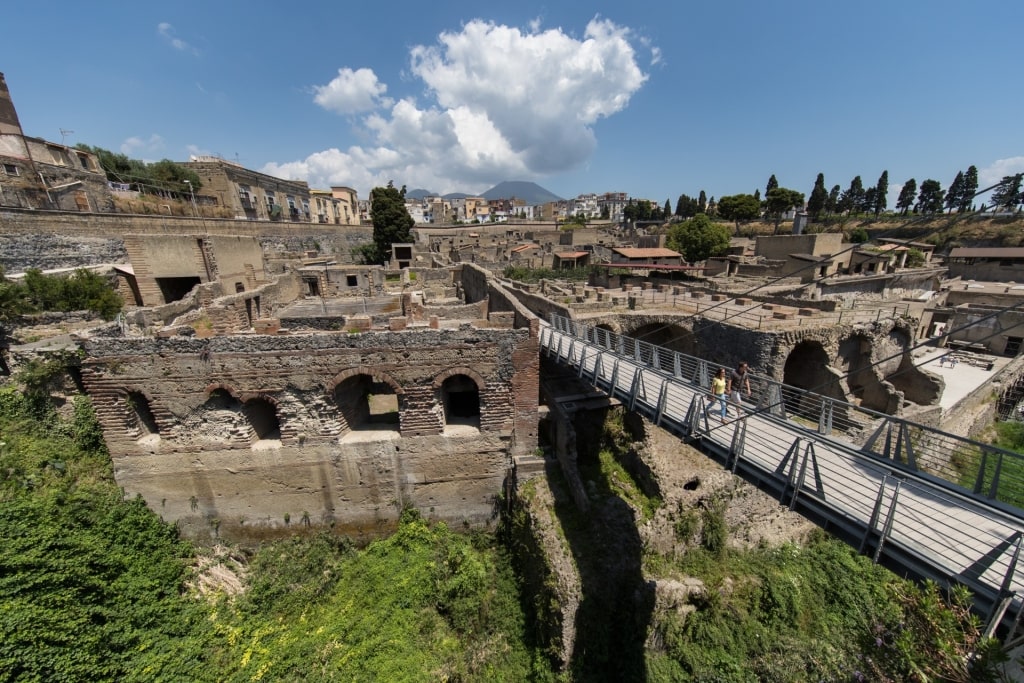
Herculaneum
After a day trip to Pompeii, you’ll be filled with as many questions as answers about life in the time of ancient Rome. Of course, there’s nowhere like Italy for encountering awe-inspiring remnants of this once-great empire.
However, for a more focused, Pompeii-related perspective, there are a couple of outstanding additional visits that you could make while in the Neapolitan area.
Herculaneum
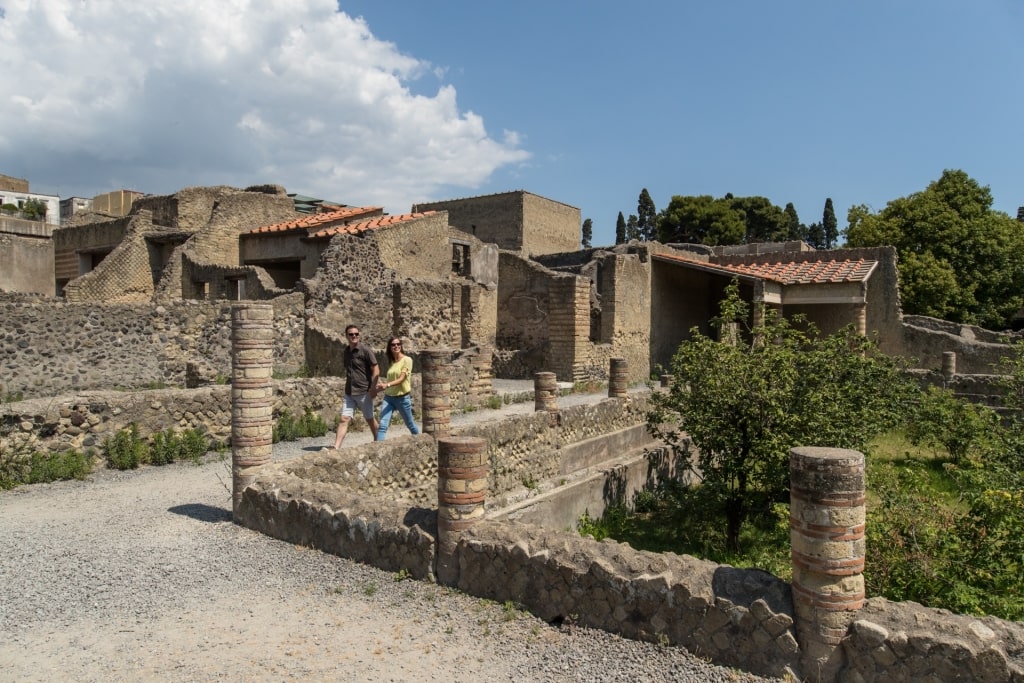
Herculaneum
One of the best places to visit in Southern Italy, this smaller archaeological site, once a seaside resort catering to Roman elites, was buried during the same eruption that obliterated Pompeii.
Arriving at this UNESCO-protected location is an experience in itself. It’s located within a neighborhood in Naples where you drive past modern apartment blocks until you arrive at a depression in the earth. Peering down, you’ll see the rich mosaics and well-preserved ruins that used to be submerged beneath street level.
With a visit taking around two hours, Herculaneum offers a more succinct as well as better preserved slice of life in 79 AD than Pompeii.
National Archaeological Museum of Naples
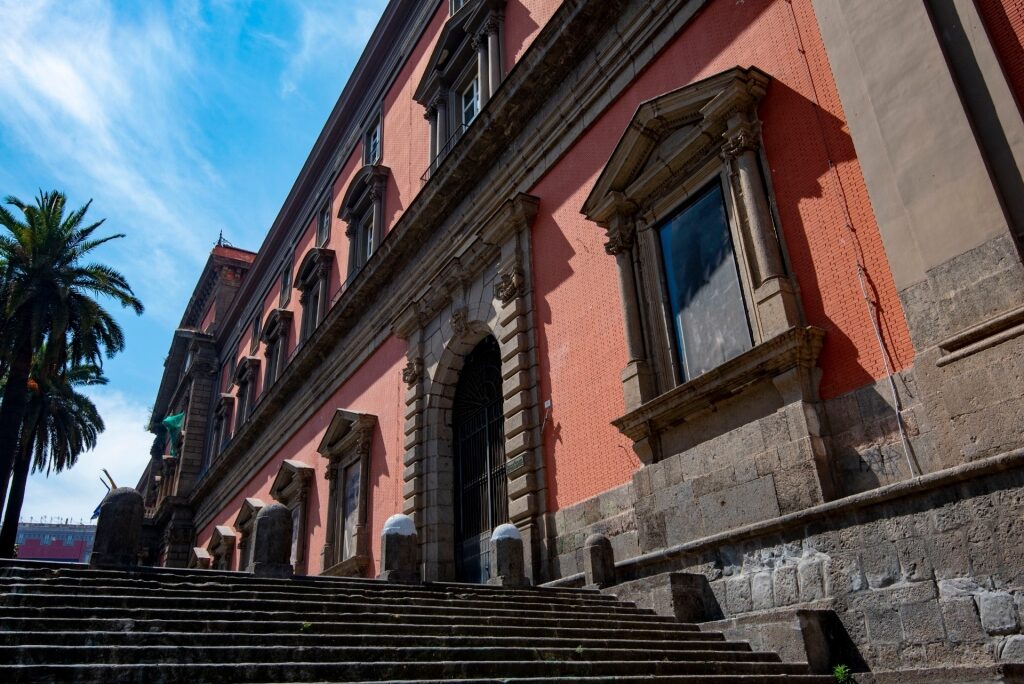
National Archaeological Museum of Naples
Located in Naples’ historic center, the National Archaeological Museum of Naples is a must visit after a Pompeii day trip. While touring through the Pompeii site, you’ll encounter a steady stream of references to artifacts that have been removed from the site to the museum for preservation.
As such, a visit there is one of the best things to do in Naples as it’s like having detailed pencil sketches suddenly bloom with color. Artifacts include everything from erotic art to everyday utensils.
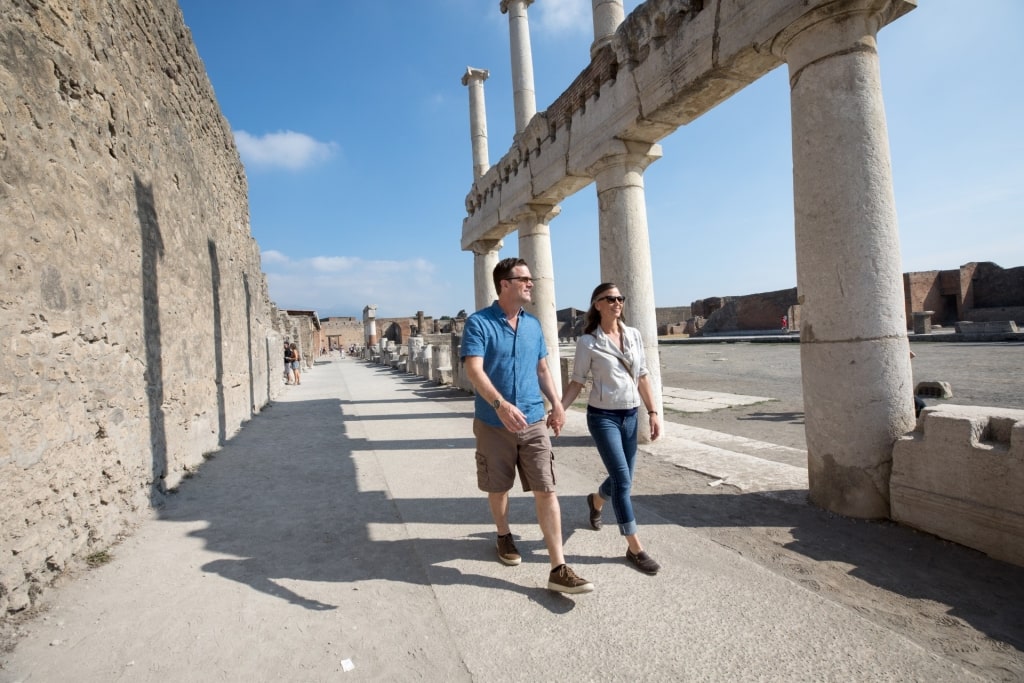
Pompeii
Discover the treasures of Pompeii and beyond with Celebrity on a cruise to Italy. Browse itineraries on our website and book your next getaway.
